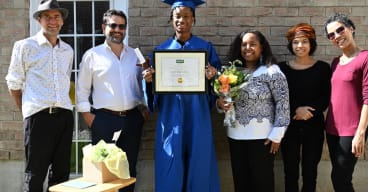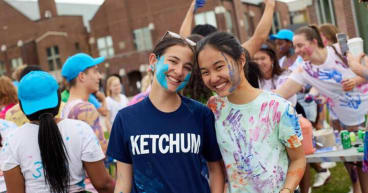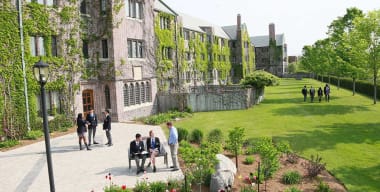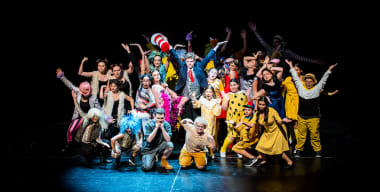Choosing a school for a less physically active child
Exploring a less physically active child's school fit
Kids vary widely in their physical activity level: while some are very active, others aren’t. Don’t underestimate the importance of your child’s activity level on school choice: it can play a big role in finding the right fit.
Less physically active kids are more sedentary. They tend to move around less in the classroom and out.
Below, we identify key points you should reflect on when considering 10 different school types for your less physically active child. Note: our aim isn’t to tell you whether a school type is right or wrong for you, but to highlight some critical factors you should consider when making your decision.
To learn about how to choose the right school in general, read the Our Kids’ step-by-step advice guide and our expert tips. To get school-choice advice customized to your child's unique traits, create a child profile through your user account and read our seven ways to choose a school based on your child's needs (i.e., overall fit, more academic challenge, social struggles, academic struggles, intensive learning interests, university preparation, and special needs.).
Less physically active kids’ fit in 10 school types
On this page:
School size
Gender
Curriculum
Living arrangements
School size
Big school (151+ students)
If your child is looking to get more physically active, they’ll benefit from the wide range of extracurriculars at big schools, such as sports and nature walks. In addition to improving their physical and mental health, these activities can help them broaden their horizons and come out of their shell.
Just make sure any prospective school, no matter the size, provides the right academic and social environment to help your less active child focus on their work and feel like they belong. This is especially important at big schools, which sometimes have bigger classes (with less one-on-one support) and can be more socially overwhelming. That said, the bigger the school, the more diverse the student body (in terms of personalities, interests, etc.), which can make it easier for your child to find a group of like-minded peers.
Small school (150 students or less)
If your child is looking to get more physically active, make sure a small school offers plenty of opportunities to do this. This makes it especially important to ask about a school’s extracurriculars—such as team sports—which can improve your child's physical fitness and enable them to broaden their horizons.
Smaller schools often have small and intimate classrooms, where your less active child can work independently and in small groups, allowing them to focus on academics in a peaceful, structured, and supportive environment. With tight-knit, less intimidating communities, small schools can also help your child come out of their shell.
Gender
Coed school
Make sure to ask about the student culture at a coed school, i.e., about how boys and girls work, interact, and get along together, to gauge whether your less active child is a good fit. While coed schools typically provide a wide range of physical activities, which is good for both more and less active kids, they sometimes have gender-stereotypical segregation in the selection of activities: for instance, more boys may participate in sports than girls, and more girls may participate in dance than boys. This can make some kids reluctant to take part in certain physical activities, especially if they’re on the shy or introverted side.
Girls' school
Girls’ schools enable your less active daughter to pursue physical activities free of gender-stereotypical segregation, e.g., where more boys may participate in sports, or more girls participate in dance. She also won’t have to negotiate the complexities of boy-girl interactions, which can be very challenging, especially for girls on the shy or introverted side. In this lower pressure environment, your daughter can focus on her studies and on finding a group of like-minded friends.
In fact, some girls blossom in an all-girls setting. “When she first started, she never raised her hand and didn't want to try anything new,” says Catherine Wang, mother of Skyler, a student at an all-girls school. “And now coming out of this first year, she's happy, she’s excited, and enthusiastic to try new things. She’s willing to put up her hand. She’s getting in front of people and doing oral presentations and school plays.”
Boys' school
If you’re considering a boys’ school for your less active son, make sure it isn’t too focused on “high energy” boys. While physical activities like sports have benefits for all boys, your son may sometimes prefer to sit quietly and read a book or work on a project, and it’s important to ensure he’ll have ample opportunity to do this.
Of course, having the ability to participate in a wide range of physical pursuits may help your son come out of his shell, explore new parts of himself, and scratch a latent itch for interaction. To gauge whether your son is the right fit, ask any prospective school about its approach to boys’ education and social and personal development.
Curriculum
Montessori school
At a Montessori school, your less active child will often work independently on their own tasks, e.g., in two-hour-plus uninterrupted work periods, during which they can pursue quieter learning activities. Since many of these schools don’t have recess, this will also give your child more time to focus on their work, pursue their interests, and absorb knowledge. Another benefit for your child: they’ll sometimes work in small groups with kids of different ages, where they’ll learn from and mentor their peers, which can help them become more assertive and confident, learn critical social skills, and come out of their shell.
If your child is looking to get more physically active, just make sure a school offers plenty of opportunities to do this.
Reggio Emilia school
If your child is looking to get more physically active, most Reggio Emilia schools offer plenty of opportunities to do this. They tend to offer plenty of unstructured social time as well as exploratory field trips and activities (e.g., in nature).
In Reggio Emilia schools, teachers consider each child’s relationship to one another and aim to promote positive connections between them, a blessing for less active kids (as it is for more active kids). The warm, community feel of the Reggio classroom—which is set up to promote lots of interaction—can help your child feel at home, connect with classmates, and develop important social skills.
Given the social and dynamic environment of the Reggio classroom, just make sure your child will get enough time on their own, in and outside of class, to replenish their energy and psychological resources.
International Baccalaureate school
If your child is looking to get more physically active, IB schools offer plenty of opportunities to do this. From PYP (Primary Years Programme) to DP (Diploma Programme), the IB offers a robust physical and health education program that promotes physical activity and holistic health, through sports, exploration, interaction, skills, and knowledge.
IB schools also give your less active child the opportunity to learn and interact with a bright, motivated, and ambitious group of kids who may have interests similar to them. Due to the IB’s heavy focus on group work, the programme offers a highly social and collaborative learning environment, which can help your child get to know their peers well, interact more, and hone their social skills. Given the IB’s focus on social learning, just make sure your child will get enough time on their own, in and out of class, to replenish their energy.
Language immersion school
The demanding curriculum of language immersion schools, which requires students to learn all or most of their subjects in a second language, is a nice fit for many less-active kids who enjoy the challenge of high-level learning. They’ll be able to focus on their studies in a structured learning environment with studious and motivated peers, who may share a passion for learning.
Since learning in a second language makes it difficult to negotiate social interaction in class, make sure your child has ample time to interact outside of class, which all kids need. Also, if they're looking to get more physically active, look into how much unstructured social time and what kinds of after-school activities a school offers (e.g., individual and team sports).
Living arrangements
Boarding school
If your child is looking to get more physically active, they’ll benefit from the wide range of extracurriculars at these schools—such as sports and nature walks. This can improve their physical and mental health. It can also help them broaden their horizons and come out of their shell. Your child may join one or more of the many non-physical supplementals these schools offer, such as an after-school robotics or book club.
Ensure, though, that the school will give your child ample downtime to rest and replenish the energy they expend. “Consider, too, whether your child will be comfortable and confident while living away from home, and while having to navigate the various, and sometimes unforeseen social-emotional experiences, alongside the academic challenges,” says Joanne Foster, education expert and author of ABCs of Raising Smarter Kids.
Less physically active kids’ school fit: key take-homes
- If your child is looking to get more physically active, they’ll benefit from the wide range of extracurriculars at big schools—such as sports, outdoor field trips, and nature clubs.
- Smaller schools often have small and intimate classrooms, where your less active child can work independently and in small groups, allowing them to focus on academics in a structured and supportive environment.
- While coed schools normally provide myriad physical activities, they sometimes have gender-stereotypical segregation in the selection of activities (for instance, more boys may participate in sports than girls), which means some kids are less likely to participate.
- If you’re considering a boys’ school for your less active son, make sure it isn’t too focused on “high energy” boys: while physical activities like sports have benefits for everyone, your son may sometimes prefer to sit quietly and read a book or work on a project.
- At a Montessori school, your less active child will often work independently on their own tasks, e.g., during two-hour-plus uninterrupted work periods, where they can focus on their preferred tasks.
- Given the social and dynamic environment of the Reggio Emilia classroom, make sure your less active child will get enough time on their own, in class and out, to replenish their energy and psychological resources.









